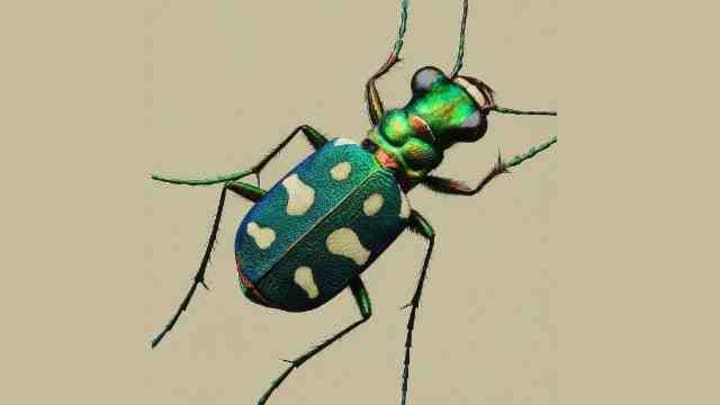Have you ever encountered a dazzling green insect flitting across sandy patches on a hot summer day? If so, you might have witnessed the captivating Cicindela sylvatica, also known as the Green Tiger Beetle. This video delves into the fascinating world of this rare and beautiful insect, exploring its identification, interesting facts, and cultural significance.

Identifying the Green Tiger Beetle:
The Green Tiger Beetle boasts a vibrant emerald green body with a hint of purple, making it a true visual spectacle. Its head and thorax are finely punctured, while the wing covers (elytra) display a unique texture, appearing slightly rough with pale yellow markings. These markings resemble interrupted crescents on the shoulders and apex, with a short, wavy band in the middle.

Here are some key features to help you identify the Green Tiger Beetle:
Color: Green with hints of purple
Size: Smaller than similar species, typically around 1cm in length
Body: Cylindrical, streamlined for swift movement
Markings: Pale yellow interrupted crescents on the shoulders and apex of the elytra, with a short, wavy band in the middle
Habitat: Sandy areas, often near open fields or forests

A Life Dedicated to Speed:
The Green Tiger Beetle is renowned for its incredible speed and agility. They are aptly nicknamed "tiger beetles" due to their predatory nature and lightning-fast movements. Their powerful legs enable them to sprint at speeds exceeding 50 body lengths per second, making them one of the fastest insects on Earth. This impressive feat allows them to effectively hunt other smaller insects, primarily ground-dwelling prey like beetles, ants, and spiders.

Beyond Beauty: Cultural Significance of the Green Tiger Beetle:
While not as widely known as some other insects, the Green Tiger Beetle holds a special place in certain cultures. In Japan, they are considered symbols of good luck and fortune, often associated with wealth and prosperity. This association likely stems from their vibrant green color, which is traditionally linked to luck and prosperity in Japanese culture.

In contrast, some Native American tribes viewed tiger beetles, including the Green Tiger Beetle, with a different lens. They were sometimes seen as messengers or spiritual guides, connecting the human world to the spirit realm. This perception likely arose from their swift movements and elusive nature, often disappearing from sight as quickly as they appear.

A Rare Gem: Conservation Efforts for the Green Tiger Beetle:
Unfortunately, the Green Tiger Beetle faces significant threats due to habitat loss and fragmentation. Their dependence on specific sandy environments makes them vulnerable to human development and activities that disrupt these delicate ecosystems. This, coupled with their naturally restricted range, has led to a decline in their population across various regions.

Conservation efforts are crucial to ensuring the survival of this unique and beautiful insect. Protecting and restoring natural habitats, particularly sandy areas in and around forests, plays a vital role in safeguarding the Green Tiger Beetle's future. Additionally, raising awareness about their importance and beauty can contribute to their conservation by fostering a sense of appreciation and responsibility for protecting our biodiversity.

Conclusion:
The Green Tiger Beetle, with its captivating emerald green hues and remarkable speed, is a testament to the wonders and diversity of the insect world. Understanding its identification features, ecological role, and cultural significance allows us to appreciate its unique place in our natural environment. By actively supporting conservation efforts, we can ensure that future generations have the opportunity to encounter this fascinating creature and witness its vibrant presence in our world.
This article was previously published on Medium.






Comments
There are no comments for this story
Be the first to respond and start the conversation.